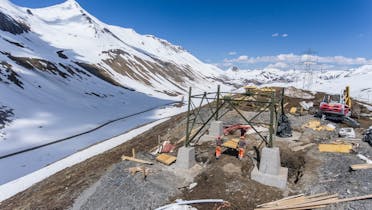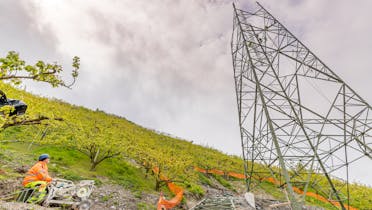
Whether it be communication, transportation, healthcare, industry or commerce, there are practically no areas of our society that can run without electricity. The transmission system is the backbone of Switzerland’s electricity supply and plays a key role in this regard.
As the operator of this critical infrastructure, Swissgrid has to ensure the resilience of the transmission grid. Specifically, this means the transmission grid must continue to operate without disruption despite any shocks that may occur. On the one hand, damage must be avoided, and on the other hand, operation must be maintained and restored to a sustainable state despite any damage. The topic of «security» therefore occupies a prominent position in the corporate strategy and is also one of Swissgrid’s corporate objectives. Swissgrid consistently, comprehensively and efficiently tackles the entire area of security while always considering ethical, economic and social principles as well as the statutory framework conditions.
In a three-part blog series, we explain how Swissgrid creates resilience in the transmission grid in the areas of installations, operation and supply as well as in relation to the human factor. The first part of this series is dedicated to installations and operation.
Problems can occur at any time
Installations such as overhead lines and substations are virtually defenceless against environmental influences. The most common causes of faults include environmental influences, such as lightning strikes, wind, heat, avalanches or mudslides. Even if lines and installations are built in a suitably robust manner, there are cases in which environmental incidents damage individual grid elements. This can be a single tree that falls during a storm and damages a conductor. But it can also be a major incident. At the end of October 2018, for example, the extremely strong winds of the Storm «Adrian» knocked down four pylons on the Albula Pass.
With the knowledge that these kinds of incidents can occur at any time, Swissgrid must ensure the high availability of its installations through ongoing maintenance work. The focus here is on maintaining the structural integrity of the installations, technical updates or managing the environment in the vicinity of the lines. Swissgrid minimises the risk of falling trees through rigorous vegetation management near lines.
The n-1-principle (redundancy)
The redundant design and operation of the transmission system supports the resilience of the system. It is possible for individual grid elements to fail without endangering the stability of the entire system. It is critical that an outage of one element does not cause a domino effect, affect other grid elements or even cause supply disruptions.
Swissgrid operates the grid according to what is called the n-1-principle. It states that if one grid element fails, no other element may be overloaded. Ensuring the n-1-principle begins long in advance during the grid planning stage. Decommissioning of grid elements, for repair work for example, must be planned in advance and with the involvement of partners in Switzerland and abroad. Forecast calculations can be used to predict the loads on individual grid elements on a model. The planning is continuously refined and adapted all the way up to real-time operation.
It is of the utmost importance that an outage of one element does not cause a domino effect, affect other grid elements or even cause supply disruptions.
If an n-1 violation occurs in real-time operation or is foreseeable in advance, Swissgrid may take measures to eliminate the congestion. This brings a current or foreseeable operational overload to below the defined threshold. This may involve preventive measures or operating procedures and may be applied nationally or internationally.
Resilience factor: modernisation
Without a doubt, the Swiss transmission grid is a success story. However, it requires permanent renewal and modernisation. Only a third of the grid dates from the period after 1980; however, the demands on the grid have changed significantly in recent years. On the one hand, new energy sources and power plants have been connected to the grid; on the other, electricity consumption has risen in recent years. With the advancement of new renewable energy resources throughout Europe, electricity generation is shifting away from large power plants with more or less constant output to many decentralised production units with fluctuating feed-in.
These constantly increasing and changing demands are already leading to structural congestion in the transmission grid today. And it is slated to increase even further in the future. This congestion must be eliminated to ensure the continued efficiency of the Swiss electricity system. The modernisation of the transmission system is therefore the key for a sustainable energy future. Drawn up by Swissgrid, the «Strategic Grid 2025» is a transparent presentation of the measures needed to expand the grid. The long-term planning of the grid infrastructure is an ongoing process: in 2021, Swissgrid is establishing the conditions for developing the «Strategic Grid 2040». In doing so, Swissgrid is making an important contribution to the realisation of the energy revolution.
By contrast, long approval procedures and complaints delay construction projects and the renewal and modernisation of the grid.







